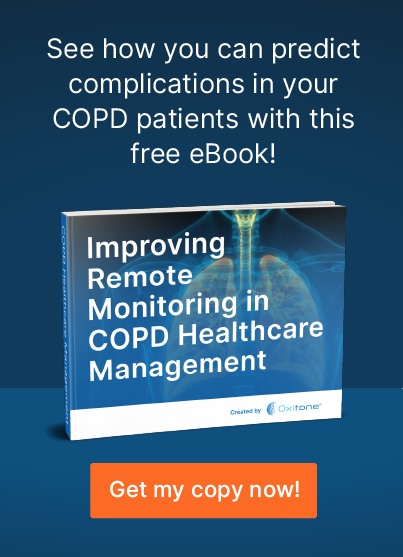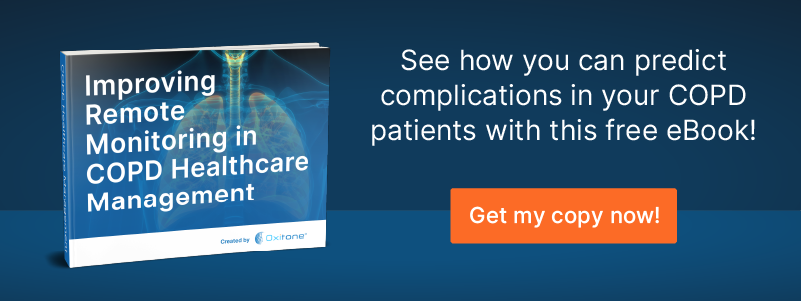Treating patients with chronic obstructive pulmonary disease (COPD) is a primary area of concern for primary care physicians (PCPs), given that these patients comprise a large demographic of the typical primary care practice. PCPs estimate that approximately 12% of their patients suffer from COPD, and the majority with mild-to-moderate COPD seek care exclusively from PCPs.
The care of COPD patients is especially important given the high risk of complications associated with the disease. COPD complications can range from partial airway collapse to memory loss and depression. Monitoring patient data, like their oxygen saturation (SpO2), with pulse oximetry can help predict such complications.
Unfortunately, traditional periodic patient monitoring only allows PCPs to see a snippet of the data that guides their decision-making for these patients. As a result, patients may experience complications or hospitalizations that may have otherwise been avoided. Enter pulse oximeter continuous monitoring.
Increasing the availability of data through continuous remote patient monitoring can significantly improve the lives of COPD patients by predicting complications and reducing hospitalizations. Pulse oximeter continuous monitoring is a convenient way to collect this data, and it further enhances the quality of patient care by engaging COPD patients outside the doctor’s office.
Let’s go over how traditional periodic patient monitoring problems are being alleviated via pulse oximeter continuous monitoring with Oxitone and other wearable medical devices.
Problems with Periodic Patient Monitoring
Historically, it has been difficult for PCPs to engage COPD patients in the self-management of their condition, though studies show that COPD patients are open to taking a more active role in their care. Periodic patient monitoring offers few opportunities for patients to get involved in self-management, outside of making and keeping regular doctor’s appointments.
Due to its heavy reliance on in-person appointments, periodic patient monitoring is labor-intensive for both patients and doctors. Requiring patients to take time off work and arrange transportation creates a burden that patients may prefer to avoid. As a result, patients may skip necessary appointments, costing the practice money and impairing continuity of care. In the long run, this could result in exacerbations, complications, and hospitalizations that could have otherwise been prevented through continuous remote patient monitoring.
In turn, doctors are required to devote a valuable portion of the practice’s resources to the care of chronic disease patients, such as those with COPD. These standing appointments consume time and money that could otherwise be spent taking care of additional patients. Thus, periodic patient monitoring limits the amount of care that physicians can provide to their patients without COPD or other chronic conditions requiring intensive care.
When it comes to healthcare costs, supply-chain management is the second largest expense for healthcare providers. Resources are wasted in the current one-directional model by failing to account for clinical patient outcomes when analyzing the system’s cost-effectiveness. Transitioning from a model of periodic patient monitoring to one of continuous remote patient monitoring could improve this and other obstacles for patients and physicians alike by conserving resources and allowing for more consistent observation of clinical outcomes.
Why Continuous Remote Patient Monitoring?
SpO2 is thought to be predictive of complications in COPD patients, including hospitalizations. Currently, this metric is used to guide clinical decision-making, but periodic patient monitoring offers only a brief snapshot of SpO2 measurements.
Wearable medical monitors like Oxitone provide a continuous stream of data about the patient’s vital signs, which is then used by PCPs to make clinical decisions for their care. For example, pulse oximetry continuous data enables them to predict fluctuations in SpO2 that precede exacerbations and hospitalizations, improving patient care and reducing healthcare costs.
By reducing the need for follow-up appointments, predicting complications, and preventing hospitalizations, wearable monitors improve the quality and continuity of care. Because they are wearable, these devices also engage patients in their care outside the doctor’s office.
Studies show that personalized care and shared decision-making (i.e., patient engagement) significantly improve clinical outcomes in COPD patients, and pulse oximeter continuous monitoring is one way to achieve that. Patients are asked to put on the monitor each day and ensure that they are using it properly—a small step that allows them to become more involved in their care.
Unlike traditional monitoring methods, sophisticated wearable monitors like Oxitone can collect data on additional lifestyle factors like sleep and exercise. This allows doctors to further assess the factors that may play a role in improving (or worsening) the symptoms of patients with COPD.
As a result, patients can avoid hospitalizations, doctors can avoid high healthcare costs and low follow-up rates, and both groups benefit from improved quality of care. Wearable medical monitors are the way of the future when it comes to the continuous remote monitoring of COPD patients.
Here at Oxitone, we boost value-based healthcare by delivering extraordinary patient, clinical, and economical outcomes at reduced medical utilization and cost. Patients need a prompt response to emergencies. Physicians need an easy and timely follow-up with patients. Our mission is to transform chronic disease management and help save lives worldwide.
Let’s save lives together! To see how we help remote patient monitoring companies and physicians improve the management and care of high-risk patients, contact us today!


